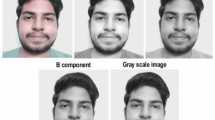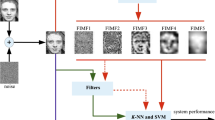Abstract
This paper presents a novel technique for improving face recognition performance by predicting system failure, and, if necessary, perturbing eye coordinate inputs and repredicting failure as a means of selecting the optimal perturbation for correct classification. This relies on a method that can accurately identify patterns that can lead to more accurate classification, without modifying the classification algorithm itself. To this end, a neural network is used to learn ’good’ and ’bad’ wavelet transforms of similarity score distributions from an analysis of the gallery. In production, face images with a high likelihood of having been incorrectly matched are reprocessed using perturbed eye coordinate inputs, and the best results used to “correct” the initial results. The overall approach suggest a more general approach involving the use of input perturbations for increasing classifier performance in general. Results for both commercial and research face-based biometrics are presented using both simulated and real data. The statistically significant results show the strong potential for this to improve system performance, especially with uncooperative subjects.
Preview
Unable to display preview. Download preview PDF.
Similar content being viewed by others
References
Brunelli, R., Poggio, T.: Face Recognition: Features versus Templates. IEEE Trans. Pattern Anal. Mach. Intell. 15, 1042–1052 (1993)
Valentin, D., Abdi, D.: O.Toole, J., and Cottrell, G. Connectionist Models of Face Processing: A Survey. Pattern Recog. 27, 1209–1230 (1994)
Riopka, T.P., Boult, T.: The Eyes Have It. In: Proceedings of the ACM Biometrics Methods and Applications Workshop, Berkeley, CA, pp. 33–40 (2003)
Marques, J., Orlans, N.M., Piszcz, A.T.: Effects of Eye Position on Eigenface- Based Face Recognition Scoring. Technical Paper, Mitre Corp. (2003)
Okada, K., Steffens, J., Maurer, T., Hong, H., Neven, H., von der Malsburg, C.: The Bochum/USC Face Recognition System and How It Fared in the FERET Phase III Test. In: Wechsler, et al. (eds.) Face Recognition: From Theory to Applic., pp. 186–205 (1998)
Penev, P.S., Atick, J.J.: Local feature analysis: A general statistical theory for object representation. Neural Systems 7, 477–500 (1996)
Bolme, D.S., Beveridge, J.R., Teixeira, M., Draper, B.A.: The CSU Face Identification Eval. System: Its Purpose, Features, and Structure. In: ICVS 2003, pp. 304–313 (2003)
Daubechies, I.: Orthonormal Bases of Compactly Supported Wavelets. Comm. Pure Appl. Math. 41, 909–996 (1988)
McClelland, J., Rumelhart, D.: Explorations in Parallel Distributed Processing, vol. 1 & 2. MIT Press, Cambridge (1986)
Author information
Authors and Affiliations
Editor information
Editors and Affiliations
Rights and permissions
Copyright information
© 2005 Springer-Verlag Berlin Heidelberg
About this paper
Cite this paper
Riopka, T., Boult, T. (2005). Classification Enhancement via Biometric Pattern Perturbation. In: Kanade, T., Jain, A., Ratha, N.K. (eds) Audio- and Video-Based Biometric Person Authentication. AVBPA 2005. Lecture Notes in Computer Science, vol 3546. Springer, Berlin, Heidelberg. https://doi.org/10.1007/11527923_89
Download citation
DOI: https://doi.org/10.1007/11527923_89
Publisher Name: Springer, Berlin, Heidelberg
Print ISBN: 978-3-540-27887-0
Online ISBN: 978-3-540-31638-1
eBook Packages: Computer ScienceComputer Science (R0)




